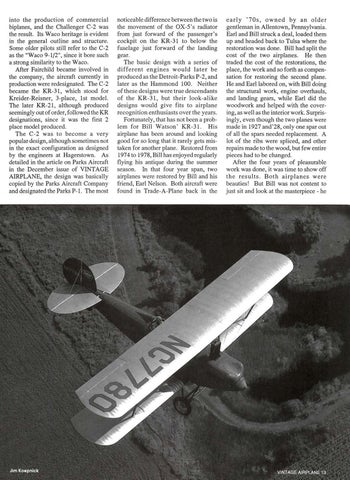into the production of commercial biplanes, and the Challenger C-2 was the result. Its Waco heritage is evident in the general outline and structure. Some older pilots still refer to the C-2 as the "Waco 9-1/2", since it bore such a strong similarity to the Waco. After Fairchild became involved in the company, the aircraft currently in production were redesignated. The C-2 became the KR-31, which stood for Kreider-Reisner, 3-place, 1st model. The later KR-21, although produced seemingly out of order, followed the KR designations, since it was the first 2 place model produced. The C-2 was to become a very popular design, although sometimes not in the exact configuration as designed by the engineers at Hagerstown. As detailed in the article on Parks Aircraft in the December issue of VINTAGE AIRPLANE, the design was basically copied by the Parks Aircraft Company and designated the Parks P-1. The most
noticeable difference between the two is the movement of the OX-5's radiator from just forward of the passenger's cockpit on the KR-31 to below the fuselage just forward of the landing gear. The basic design with a series of different engines would later be produced as the Detroit-Parks P-2, and later as the Hammond 100. Neither of these designs were true descendants of the KR-31, but their look-alike designs would give fits to airplane recognition enthusiasts over the years. Fortunately, that has not been a prob lem for Bill Watson' KR-31. His airplane has been around and looking good for so long that it rarely gets mis taken for another plane. Restored from 1974 to 1978, Bill has enjoyed regularly flying his antique during the summer season. In that four year span, two airplanes were restored by Bill and his friend, Earl Nelson. Both aircraft were found in Trade-A-Plane back in the
early '70s, owned by an older gentleman in Allentown, Pennsylvania. Earl and Bill struck a deal, loaded them up and headed back to Tulsa where the restoration was done. Bill had split the cost of the two airplanes. He then traded the cost of the restorations, the place, the work and so forth as compen sation for restoring the second plane. He and Earl labored on, with Bill doing the structural work, engine overhauls, and landing gears, while Earl did the woodwork and helped with the cover ing, as well as the interior work. Surpris ingly, even though the two planes were made in 1927 and'28, only one spar out of all the spars needed replacement. A lot of the ribs were spliced, and other repairs made to the wood, but few entire pieces had to be changed. After the four years of pleasurable work was done, it was time to show off the results. Both airplanes were beauties! But Bill was not content to just sit and look at the masterpiece - he
